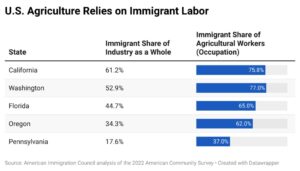Almost one in every seven people in the United States is an immigrant, according to the American Immigration Council’s new analysis of the 2022 American Community Survey. The updated state-level data from the Council’s Map the Impact tool reveals how immigrants—including those who are undocumented—make crucial contributions through their work in vital industries, starting businesses, and paying taxes.
In 2022 alone, immigrant households paid $579.1 billion in total taxes—nearly one in every six tax dollars collected by federal, state, and local governments.
Here is a breakdown of immigrants’ contributions in healthcare, agriculture, construction, and entrepreneurship.
Healthcare
The Bureau of Labor Statistics projects that the country will face a shortage of 134,940 healthcare providers by 2036. Immigrants are already playing a vital role filling healthcare workforce gaps. Nationally, 15.6% of all nurses and 27.7% of all health aides are immigrants. In New York and New Jersey, over half of all health aides are foreign-born. In five states (California, New Jersey, Maryland, New York, and Florida) over 1 in 4 nurses are immigrants. In Michigan, Ohio, and Pennsylvania, over 1 in 4 physicians are immigrants.

Agriculture
While agriculture, food, and related industries contributed roughly $1.5 trillion to U.S. GDP in 2023, we are increasingly relying on imported produce. Scarcity in farm labor is one reason farmers are struggling to keep production levels up. Immigrant workers are a crucial part of the agricultural workforce, putting food on our tables and supporting our communities.
Nationwide, 54.3% of graders and sorters of agricultural products are immigrants, as are 25.3% of workers in the agriculture industry overall.

U.S. farmers rely on skilled workers to produce the food we all depend on. In some states, immigrants are more than half of the agricultural workers.
Construction
Similarly, immigrants play a key role in building new homes to help ease the burden of high housing prices. Many American cities are facing housing shortages. Scarcity of skilled workers in the field is only exacerbating this problem, according to a 2023 report from the Home Builders Institute. The Associated Builders and Contractors trade association estimates a shortage of about 500,000 workers in the construction industry in 2025.
Immigrants, again, are key to filling these roles and working to address housing shortages. One in four workers in the construction industry were immigrants in 2022. In 11 states, this share was even higher. In California and Texas for example, over 40% were immigrants.

Entrepreneurship and Innovation
Immigrants not only fill vacant roles, but directly create jobs by starting businesses and playing a key role in innovation.
Immigrants start and run businesses at higher rates than their U.S.-born counterparts. These businesses enrich our main streets, employ community members, and help fuel our economy. Despite making up just 13.8% of the population, in 2022 immigrants made up more than one in five entrepreneurs (22.6%) in the United States, generating over $110 billion in business income.

In California, Florida, New Jersey, and New York, immigrants represented more than one in three business owners. In every state, immigrants were over-represented as entrepreneurs compared with their share of the overall population.
To advance innovation, the country needs experts in STEM (science, technology, engineering, and mathematics) fields. Immigrants are a crucial part of America’s STEM workers, making up 23.1% of the country’s STEM workers in 2022. In Pennsylvania and Washington states, over 40% of miscellaneous physical scientists are foreign-born. Software developers are also particularly likely to be immigrants—in Washington state, over half of employees in the occupation are foreign-born.
Undocumented Immigrants
As of 2022, an estimated 21.6% of immigrants living in the United States are undocumented—the vast majority of whom were working, paying taxes, and contributing to our communities. In five states—Arkansas, Utah, Tennessee, Kansas, and Oklahoma—more than one out of every three immigrants are undocumented.
Despite restrictions in travel, work, and access to opportunities, undocumented immigrants are finding ways to persevere and continue to contribute to the country as a whole. In 2022, undocumented households paid $35.1 billion in taxes, including $25.1 billion in federal taxes and $13.6 billion in state and local taxes.
Policies that affect undocumented immigrants will and do affect U.S.-born Americans in many ways. About 7.6 million U.S.-born Americans currently live with an undocumented family member, and 3.7 million U.S.-born children currently live with an undocumented parent.
Polices that serve undocumented immigrants—such as Deferred Action for Childhood Arrivals—provide pathways for these individuals to legally find work and continue to contribute to our economy in meaningful ways. In 2022, DACA-eligible immigrants had an employment rate of a 96.1%.
Becoming American
Over half of all immigrants in the United States are naturalized citizens, putting down their roots and contributing to their local communities. Immigrants who entered the United States as refugees are particularly likely to be naturalized—80.8% of refugees are naturalized nationally. Vermont, Montana, West Virginia, New Hampshire, Hawaii, Minnesota, and New York have the highest naturalization rates among immigrants. In these states, at least 60% of immigrants are naturalized.
Immigrants of all skill levels are vital to our economy and country. From agriculture to tech, the United States relies on immigrants to ease the labor shortage, foster innovation, and start businesses that create jobs for all Americans. Our latest data shows how immigrants have become an integral part of the U.S. economy and made significant contributions.
FILED UNDER: Immigrant Workers

